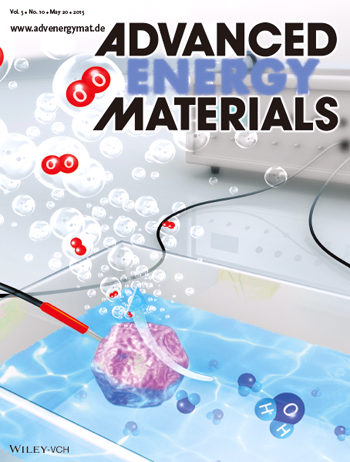| Efficient Electrocatalytic Water Oxidation by Using Amorphous Ni–Co Double Hydroxides Nanocages |
| From: PublishDate:2016-06-03 Hits: |
The electrochemical water splitting into hydrogen and oxygen has been broadly believed as one of the most promising approaches to obtain clean fuels from renewable energy sources. In practice, however, the high overpotential caused by sluggish oxygen evolution reaction (OER), i.e. water oxidation process, at the anodic electrode dramatically diminishes the overall effectiveness of the water splitting in the electrochemical cell. Catalysts, therefore, are always in need. However, the water oxidation catalysts reported so far are mainly rely on crystalline or solid materials, which still encounter some intrinsic disadvantages like low stability during the long term electrochemical reaction. A collaborated team from Beihang University and the National Center for Nanoscience and Technology has explored, for the first time, the feasibility of the amorphous hollow nanomaterials for efficient electrochemical water oxidation. Their research has been published on March 9th, 2015 in Advanced Energy Materials and chosen by editor as a cover.
A unique template-engaged approach was employed by the team for fabrication of amorphous hollow nanomaterials. Ni-Co amorphous double hydroxides (ADHs) nanocages are chosen to demonstrate this feasibility, in view of the limited success in synthesizing cage-like structure of these materials, and emerging application of the hydroxides in water oxidation. Inside structural information of this amorphous catalyst, such as oxidation states, bond distances and coordination numbers, have been obtained by the X-ray absorption near-edge structures (XANES) and the extended X-ray absorption fine structure (EXAFS) characterization using synchrotron radiation at BSRF. These data suggests a larger extent of disorder and distortion in the catalyst. Low coordination number of metal atoms and high disorder are analogous to that found on the high-index faces of noble-metal catalysts, which help the researcher to believe the prepared NiCo2.7(OH)x amorphous nanocages with high surface reactivity and structural stability could become promising electrocatalysts. In practical test, the high catalytic activity and excellent stability of the NiCo2.7(OH)x nanocages demonstrate the promising application of amorphous nanomaterials in water electrochemical oxidation. Density functional theory (DFT) simulation reveals that the composition-dependent electrocatalytic activities are closely related to the surface reactivity of different hydroxides. “The successful synthesis approach to Ni–Co ADHs nanocages described herein, combined with rational computational simulation, opens the avenue for rational design and controllable preparation of the amorphous nanomaterials with well-defined structure, shape, and composition for high performance catalysts.” explains Lin Guo, one of the team leader and the professor of Beihang University. Article: Jianwei Nai, Huajie Yin, Tingting You, Lirong Zheng, Jing Zhang, Pengxi Wang, Zhao Jin, Yu Tian, Juzhe Liu, Zhiyong Tang,* and Lin Guo*. Efficient Electrocatalytic Water Oxidation by Using Amorphous Ni–Co Double Hydroxides Nanocages. Adv. Energy Mater. 2015, 5, 1401880. |
|
|
| Chinese
- Beamline 1W1 of BSRF started to runoperate in the couplingparasitic mode of BEPCII
- Synthesis of High Performance Polymer Materials for Field Effect-Transistors
- Surfactant molecular aggregates in green solvents
- GIXRD has played an important role in the characterization of organic thin-film transistors
Copyright © 2011 - 2012 Beijing Synchrotron Radiation Facility


